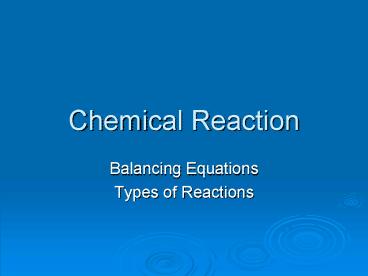Chemical Reaction - PowerPoint PPT Presentation
1 / 17
Title:
Chemical Reaction
Description:
Chemical Reaction. Balancing Equations. Types of Reactions. All chemical reactions. have two parts ... Change a subscript to balance an equation. ... – PowerPoint PPT presentation
Number of Views:92
Avg rating:3.0/5.0
Title: Chemical Reaction
1
Chemical Reaction
- Balancing Equations
- Types of Reactions
2
All chemical reactions
- have two parts
- Reactants - the substances you start with
- Products- the substances you end up with
- The reactants turn into the products.
- Reactants Products
3
Symbols used in equations
- the arrow separates the reactants from the
products ? - Read reacts to form
- The plus sign means and
- (s) after the formula -solid
- (g) after the formula -gas
- (l) after the formula -liquid
4
Symbols used in equations
- (aq) after the formula - dissolved in water, an
aqueous solution. - used after a product indicates a gas (same as
(g)) - used after a product indicates a solid (same as
(s))
5
Symbols used in equations
- indicates a reversible reaction
(More later) - shows that
heat is supplied to the reaction - is used to indicate a catalyst
used supplied, in this case, platinum.
6
What is a catalyst?
- A substance that speeds up a reaction without
being changed by the reaction. - Enzymes are biological or protein catalysts.
7
Rules for balancing
- Write the correct formulas for all the reactants
and products - Count the number of atoms of each type appearing
on both sides - Balance the elements one at a time by adding
coefficients (the numbers in front) - Check to make sure it is balanced.
8
Never
- Change a subscript to balance an equation.
- If you change the formula you are describing a
different reaction. - H2O is a different compound than H2O2
- Never put a coefficient in the middle of a
formula - 2 NaCl is okay, Na2Cl is not.
9
Types of Reactions
- Predicting the Products
10
Types of Reactions
- There are millions of reactions.
- Cant remember them all
- Fall into several categories.
- We will learn 5 types.
- Will be able to predict the products.
- For some we will be able to predict whether they
will happen at all. - Will recognize them by the reactants
11
1 Combination Reactions
- Combine - put together
- 2 elements, or compounds combine to make one
compound. - Ca O2 CaO
- SO3 H2O H2SO4
- We can predict the products if they are two
elements. - Mg N2
12
Write and balance
- Fe O2 iron (II) oxide
- Ca Cl2
- Al O2
- Remember that the first step is to write the
formula - Then balance
13
2 Decomposition Reactions
- decompose - fall apart
- one reactant falls apart into two or more
elements or compounds. - NaCl Na Cl2
- CaCO3 CaO CO2
14
3 Single Replacement
- One element replaces another
- Reactants must be an element and a compound.
- Products will be a different element and a
different compound. - Na KCl K NaCl
- F2 LiCl LiF Cl2
15
4 Double Replacement
- Two things replace each other.
- Reactants must be two ionic compounds or acids.
- Usually in aqueous solution
- NaOH FeCl3
- The positive ions change place.
- NaOH FeCl3 Fe3 OH- Na1Cl-1
- NaOH FeCl3 Fe(OH)3 NaCl
16
Complete and balance
- assume all of the reactions take place.
- CaCl2 NaOH
- CuCl2 K2S
- KOH Fe(NO3)3
- (NH4)2SO4 BaF2
17
Combustion Reactions
- Combustion
- A compound composed of only C H and maybe O is
reacted with oxygen - If the combustion is complete, the products will
be CO2 and H2O. - If the combustion is incomplete, the products
will be CO and H2O.































